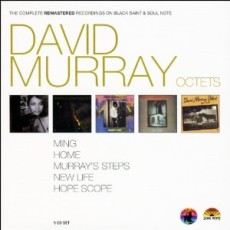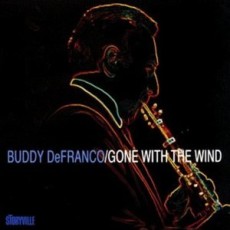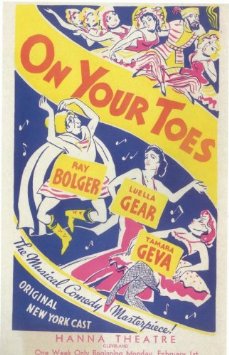
Daily Dose Of Jazz…
David Murray was born on February 19, 1955 in Oakland, California to musical parents, his mother played piano and his father, guitar. He was introduced to jazz while in the Berkeley school system playing alto in the school band. By thirteen he was in a local group called the Notations of Soul, but it was hearing Sonny Rollins that gave him the inspiration to switch from alto to tenor.
Influenced by Stanly Crouch while attending Pomona College, he moved to New York at 20 during the jazz loft era in lower Manhattan. Joining up with Crouch they opened their own loft space called Studio Infinity and Crouch occasionally played drums in Murray’s trio with Mark Dressler.
Murray’s early work was raw filed with multiphonics, extreme volume and upper register forays. By 1976 he recorded his first album “Flowers For Albert” and along with Julius Hemphill, Oliver Lake and Hamiet Bluiett became a founding member of the World Saxophone Quartet. Around the same time Joseph Papp commissioned David for a big band assemblage that enjoyed a modicum of critical success.
Through the 80’s he continued to play with the WSQ, his octet and various small bands, recording mostly for Italy’s Black Saint label, showcasing his rough and unformed talent as a composer. His recording dates became a flurry for the next two decades, leading more sessions than any other contemporary jazz musician. His playing matured and he began relying on the standard jazz repertoire when playing in small combo configurations. Yet by the time he was 40, his relative predictability was offset by his attention to the craft of playing and his inimitable style while his increased skill as a composer. In addition to winning a Grammy for Best Jazz Instrumental Group Performance for Blues for Coltrane: A Tribute to John Coltrane, over the course of his career he has been awarded a Guggenheim Fellowship, received a Bird Award, the Jazzpar Prize and has been named Musician of the Year by Newsday and Musician of the Decade by the Village Voice.
Murray mainly plays tenor saxophone and bass clarinet influenced in the free jazz genre of Albert Ayler and Archie Shepp. He has played with a host of world-renowned musicians, of which he is a member and continues to perform, record and tour.

Daily Dose Of Jazz…
Clyde Lombardi was born in February 18, 1922 in the Bronx borough of New York City. He had extensive classical training but by the time he was 20 he became a jazz musician. He became an advanced yet flexible bassist, quite valuable in the jazz world of the ’40s and ’50s, playing regularly with Red Norvo from 1942-1945.
Throughout the rest of the decade he would play with Joe Marsala and the Boyd Raeburn Orchestra in 1945, as well as both big bands and combos headed by Benny Goodman during 1945-1946 and his bebop fling of 1948-1949.
Clyde played and recorded with Charlie Ventura in 1946, Lennie Tristano, Wardell Gray, Stan Getz, Al Haig, Zoot Sims, Eddie Bert, Tal Farlow in 1953 and George Wallington among others.
Unfortunately for the jazz world he never got the opportunity to lead any albums of his own. He left jazz by 1959 re-emerging from time to time and working for CBS as a studio musician and recording with tenor Tony Graye. He passed away in New York City on January 1, 1978.
More Posts: bass

Daily Dose Of Jazz…
Buddy DeFranco was born Boniface Ferdinand Leonard DeFranco in Camden, New Jersey on February 17, 1923. By the age 14 he had won an amateur swing contest sponsored by Tommy Dorsey. Just four short years later he was working with the big bands of Gene Krupa in 1941 and Charlie Barnet in 1943. Those stints were followed with him playing off and on with Tommy Dorsey over the next few years.
Outside of a short-lived association with the Count Basie Septet in 1950, Buddy mainly lead his own bands from then on, playing and recording with Tal Farlow, Art Blakey, Kenny Drew and Sonny Clark, Art Tatum and Oscar Peterson as his sidemen, among others too numerous to name. He also played in some of Norman Granz’s Verve jam sessions and during the late 60’s DeFranco became the bandleader of the Glenn Miller Orchestra, an association that lasted until 1974. He has found more artistic success co-leading a quintet with Terry Gibbs off and on since the early 80’s and has recorded numerous albums.
Buddy DeFranco is considered one of the great clarinetists of all time and, until the rise of Eddie Daniels, he was indisputably the top clarinetist to emerge since 1940. It was DeFranco’s misfortune to be the best on an instrument that after the swing era dropped drastically in popularity and, unlike Benny Goodman and Artie Shaw, he has never been a household name for the general public and while most jazz clarinet players were unable to adapt to fading popularity, Buddy Defranco was one of the few bebop musicians who successfully continued to play clarinet exclusively until he passed away on December 24, 2014 in Panama City, Florida at age 91.
More Posts: clarinet

From Broadway To 52nd Street
On Your Toes opened at the Imperial Theater on April 11, 1936. The show ran three hundred and fifteen performances and the music and lyrics were once again composed by Richard Rodgers and Lorenz Hart. The production starred Ray Bolger, Tamara Geva and Doris Carson.
the Story: Junior Dolan, son of an old vaudevillian, becomes a music professor. He takes on the task of helping a struggling Russian ballet company. When complications arise, Junior is forced to take the place of the lead dancer and perform opposite Vera Barnova. Gangsters try to shoot him during the ballet but they are apprehended in time for a happy ending that included his proposal of marriage to sweet Frankie Frayne. From this musical came two songs that have endured as jazz classics – Glad To Be Unhappy and There’s A Small Hotel.
Broadway History: Broadway and 39th Street became the site where Aronson built The Casino with the procurement of financing from some of the wealthiest finance wizards of the day – the Goulds, Roosevelts, Vanderbilts and Morgans. When it opened I n 1882, The Casino was considered the finest example of Moorish architecture outside of Spain.
While Aronson was building his theatre, Charles Frohman had begun his separate career as the manager of theatrical professionals and in 1893 opened his own theatre. The Empire was one block up from The Casino. In November of that year Abbey’s Theatre opened next door to The Casino and the uptown migration of the theatre district continued. The Casino led the way for a number of entrepreneurs to build in the vicinity of Longacre Square, a long open promenade where Broadway crossed 7th Avenue. Following Aronson’s lead, the likes of Charles Frohman, Henry Abbey, Oscar Hammerstein and the Shuberts were among the investors and creators of the new theatre district.
Sponsored By
www.whatissuitetabu.com
More Posts: broadway

Daily Dose Of Jazz…
Pete Christlieb was born on February 16, 1945 in Los Angeles, California to bassoonist Don Christlieb. He began his musical career playing the violin at seven, adding the tenor sax by thirteen. After high school he played with diverse L.A. bands in the early 60’s including those led by Chet Baker, Woody Herman and Sy Zenter. He joined Louis Bellson in 1967 and stayed into the eighties.
He recorded his first leader session for the Jazz City label in 1971 and by the early 80’s he started his own label, Bosco Records that would issue small group albums as well as records by Bellson and Bob Florence.
Christlieb has long been in demand as a studio player and the saxophonist has played with innumerable artists including Count Basie, Benny Goodman, Quincy Jones and Sarah Vaughan while also knocking out legendary solos on Steely Dan’s Deacon Blues, Natalie Cole’s Unforgettable and the extended solo on the movie theme FM. He held a longtime seat in Doc Severinsen’s band on The Tonight Show with Johnny Carson.
Pete Christlieb, a bebop, hard bop and West coast tenor saxophonist currently plays with his group the Tall and Small Band, the Bill Holman Orchestra and his own quartet.
More Posts: saxophone






